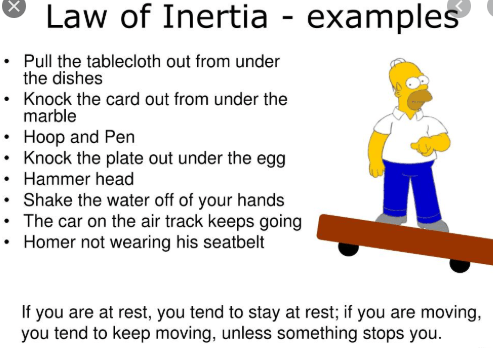Law of Inertia Examples

We have all noticed at some time that if we travel standing in the bus and it stops suddenly, our body tends to “continue traveling”, which forces us to quickly grab hold of some firm element within the bus so as not to fall.
This happens because the bodies tend to maintain their state, of rest or movement, if not for the action of a force. Physics recognizes this phenomenon as “inertia”.
So inertia is the resistance that matters opposes modifying its state of rest or motion, and a body is said to have greater inertia the greater resistance it opposes to modify its state.
Types of inertia
Physics distinguishes between mechanical inertia and thermal inertia :
- Mechanics: depends on the amount of mass and the inertia tensor. And it is exactly the one described above.
- Thermal: quantifies the difficulty with which a body changes its temperature when it comes into contact with other bodies or when heated. Thermal inertia depends on the amount of mass and heat capacity.
Ultimately, inertial forces are apparent forces that are perceived in a non-inertial reference system.
Newton’s first law
These ideas have been embodied in Newton’s first law or the law of inertia, according to which if a given body is not subject to the action of forces, it will maintain its speed in magnitude and its direction at all times without change.
However, it is interesting to say that before Newton, the scientist Galileo Galilei already raised this concept facing the Aristotelian point of view in his work Dialogues on the two great systems of the world, Ptolemaic and Copernican, dating from 1632.
There he says (in the mouth of one of his characters) that if a body slides on a smooth and perfectly polished plane, it would maintain its movement ad infinitum. But if this body were to slide on an inclined surface, it would suffer the action of a force that could cause it to accelerate or decelerate (depending on the direction of inclination).
So Galileo already glimpsed that the natural state of objects is not exclusively that of rest, but also that of a rectilinear and uniform movement, insofar as there are no other forces acting.
Associated with this physical concept, when describing human behaviors, the other meaning of the term inertia appears, which is applied to those cases in which people do nothing about something due to laziness, adherence to routine, comfort, or simply by letting themselves be as you are, which is often the easiest.
Law of inertia examples
Examples of everyday or known situations are given that account for the physical phenomenon of inertia:
- Inertial seat belts: only lock in case the body keeps moving when there is a sudden stop.
- Spin washing machine: when rotating quickly, the drum forces the clothes inside it, and the inertia of the water droplets that go through the holes follow long so that the inertia of the drops helps to remove the water from clothes.
- Tackling the ball in football: we are all very clear that if a goalkeeper does not stop the ball applied by the opposite team striker with his arms, there will be a goal. The ball in motion, due to its inertia, will continue to travel inside the arc.
- Travel by plane: even if it goes at high speed, the coffee that is served to us remains on the table attached to the seat in front, like everything else inside the plane.
- Cycling by bicycle: we can advance with our bicycle a few meters after pedaling and stop doing it, inertia makes us advance until friction or friction overcomes it, then the bicycle stops.
- Hard-boiled egg test: if we have an egg in the fridge and we do not know if it is raw or cooked, we support it on the counter, we turn it carefully, and with one finger we try to stop it: the hard-boiled egg will stop immediately because its content is already coagulated, the crude oil will move a little more because inside there is fluid.
- Remove a tablecloth and leave what is above resting on the table, in the same place: a classic inertia-based magic trick; to get it right you have to pull the tablecloth down and the object must be rather light.
- Heads of automobiles: in the face of a sudden head-on collision, they prevent the neck of the traveler from breaking, which due to inertia will tend to go backward.
- The shots with effect in the billiards or the pool: when trying to achieve the caroms, taking advantage of the inertia of the balls.
- The overturning of cars moving at high speed along the roads: when they suddenly encounter an obstacle, it is a consequence of the considerable inertia of such objects, of great mass.
Suggested Topics:
